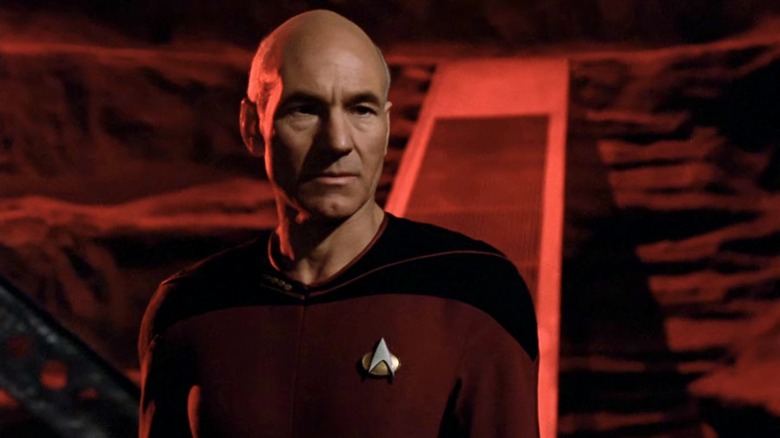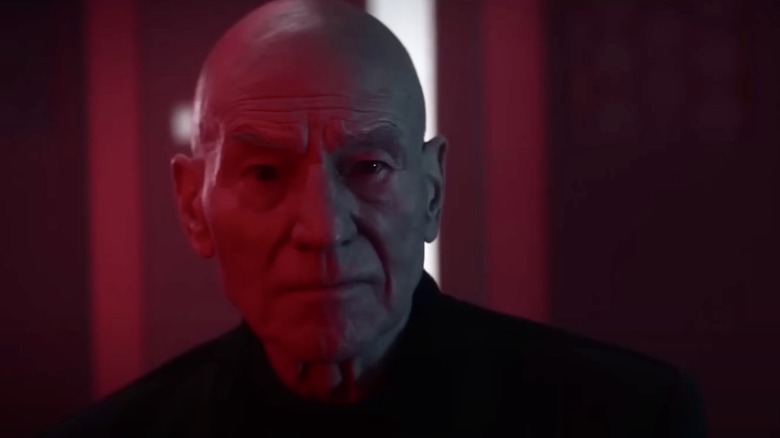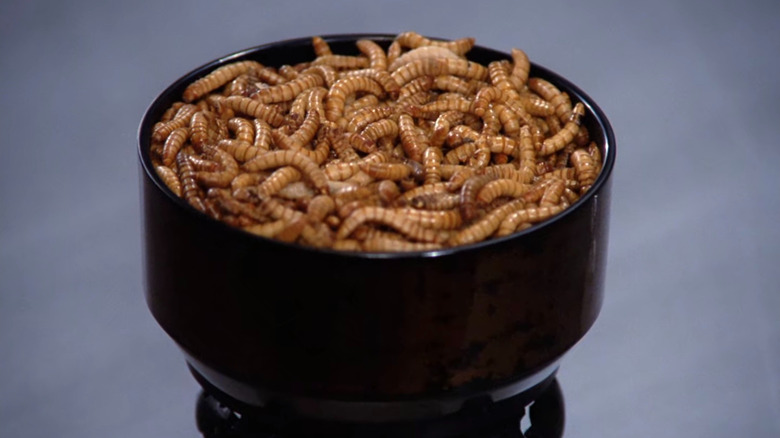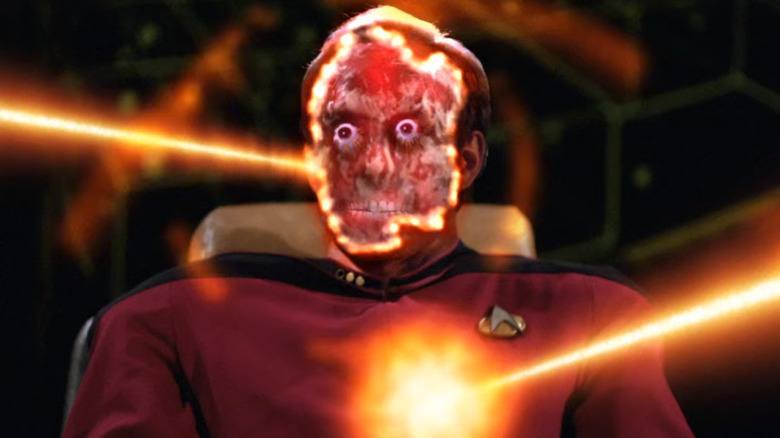Star Trek: Picard Season 3 Is Finally Delivering On The Promise Of A Classic Next Generation Episode
This post contains spoilers for "Star Trek: Picard," season 3, episode 5, "Imposter."
Someone call a Code 47, because we need to open a secure channel about the latest episode of "Picard" season 3. The show has gone to some familiar places this season — so many of them, in fact, that its continuing mission seems to be boldly going where "Star Trek" has gone before. By way of an example, in episode 5, "Imposter," Ro Laren (Michelle Forbes) shows up out of the blue after 29 years, and we learn through expository dialogue that, in the interim, she's repeated her history of being court-martialed, imprisoned, and then set free to rise through the ranks of Starfleet again.
Ro's return draws on the penultimate episode of "Star Trek: The Next Generation," and thanks to the combined acting skills of Forbes and Patrick Stewart as Jean-Luc Picard, their scenes crackle with drama and help ratchet up the tension of the Changeling conspiracy part of the plot. I can get on board with "Star Trek" as a thriller where "Starfleet is compromised at the highest level" by shapeshifting aliens. In its more credible moments (which include this episode), "Picard" and its bumpy writing have done an otherwise bang-up job of preempting Marvel's "Secret Invasion" with that kind of story. However, as long-standing (and perhaps long-suffering) Trekkies might know, it's not the first time in "Star Trek" that we've seen that kind of story.
There's another penultimate episode — going all the way back to "The Next Generation" season 1 — that got there first. "Conspiracy" featured in our ranking of the 10 best episodes of "The Next Generation," and it shares many things in common with "Picard" season 3, not the least of which is the whole alien conspiracy plot.
Conspiracy of parasites
In "Conspiracy," we see Dr. Beverly Crusher (Gates McFadden) break the Hippocratic oath and shoot an alien, like she did at the top of "Picard" season 3. The episode begins with Picard responding to an urgent message for his eyes only, just as he did with Beverly's distress call this season. He takes his ship off course (in this case, it's the Enterprise instead of the Titan) and goes to meet another old friend in a remote location.
When Picard beams down to the planet for his rendezvous with Captain Keel (Jonathan Farwell), the influence of "Conspiracy" can be seen not only in the storyline, but in the lighting, as the characters' faces are bathed in red and black. We've seen similar shading all throughout "Picard" season 3 (see above). Clearly, someone in the shadows at Paramount+ never got the memo that the bridge of a starship is supposed to be "a clean, well-lit place," as Ernest Hemingway would say.
The "Picard" episode "Imposter" differs from "Conspiracy" in the nature of the aliens that have infiltrated Starfleet. In "Conspiracy," they're parasitic lifeforms, later retconned offscreen as cousins of the Trill symbionts in a series of "Deep Space Nine" novels. The Changelings, like the Trill, were a major part of the "Deep Space Nine" TV series, being represented by two of the main characters, Odo (René Auberjonois) and Dax (Terry Farrell), respectively.
Whereas Captain Shaw (Todd Stashwick) dumbs the Changelings down as "goo-people, walking, talking clay-dough," the parasites in "Conspiracy" are organisms that crawl inside a host body and live there, with an appendage protruding from a gill in back of the host's neck. This makes it easier to identify them than the new and improved Changelings, who are now able to pass blood tests and evade detection better than before.
Worms are on the menu
In his captain's log, Picard calls the parasites in "Conspiracy" a "cancer growing within the ranks of Starfleet." Captain Keel tells him, "Don't trust anyone," which Beverly Crusher simply rephrases as, "Trust no one," in "Picard" season 3. Keel's death, like Ro's death in "Imposter," helps convince the ranking captain (Picard then, Shaw now) that the threat of the conspiracy is real.
"Conspiracy" holds further distinction as the first (and one of the few) "Next Generation" episodes to ever visit Earth, where Picard beams down to Starfleet Headquarters in San Francisco for a nice dinner — of worms. It turns out the admirals who invited him, as well as one of the other captains who was with Keel before, are all possessed by parasites. Ditto for Lieutenant Commander Remmick (Robert Schenkkan), a recurring character who first showed up a few episodes earlier to carry out an inspection of the Enterprise. That's the closest "The Next Generation" got to serializing its conspiracy plot, which was mostly a one-and-done after this episode.
"Picard" takes things to the next level and makes it the overarching plot of the whole season. It also picks up on the thread of buddy-comedy action that we see with Picard and Commander Riker (Jonathan Frakes) as they escape the dining room at the end of "Conspiracy." In their final confrontation with Remmick, who holds the parasite mother inside of him, there's a funny moment where Remmick stands up, his neck bulging, and says, "We seek peaceful coexistence," in the most malicious tone of voice. Picard and Riker take one look at each other and then blast him with their phasers until his head explodes.
Newman's Own exploding head
As mentioned in our ranking of 10 terrifying "Star Trek" episodes, which also includes "Conspiracy," the exploding-head effect for Remmick was accomplished by stuffing a mold of actor Paul Newman's face (from the Paramount props department) with raw meat and then blowing it up. That's sure one way to make Newman's Own salad dressing. Set your phasers and forks to kill.
"Conspiracy" first aired in 1988, only a few years after John Carpenter's "The Thing" hit theaters, and it's laced with the same paranoia and gross-out creature effects. Gnarly moments like when Remmick's body melts and the parasite mother emerges from his hollowed-out torso (to again be blasted into oblivion, Prime Directive be damned) helped earn the episode an Emmy Award for Best Makeup. According to the reference book "The Star Trek Chronology: The History of the Future" by Michael and Denise Okuda, the episode was originally "intended to lead to the introduction of the Borg in Star Trek: The Next Generation's second season," but "the Borg connection was dropped before [the season 2 episode] 'Q Who?' was written, and the truth about the parasites remains a mystery."
"Picard" already revisited the Borg last season, but since Changeling imposters lend themselves just as well to assimilation and body-snatching, it uses them as the antagonists this season. Ultimately, while the "Conspiracy" in "Star Trek: The Next Generation" didn't go beyond one all-time great episode, it did lay the seeds for what "Picard" is doing now. And while it's true that "Picard" sometimes leaves the same aftertaste as a bowl of worms, who knows, when all is said and done, maybe the goo-people won't make for such a bad salad dressing, either.
New episodes of "Star Trek: Picard" air Thursdays on Paramount+.



